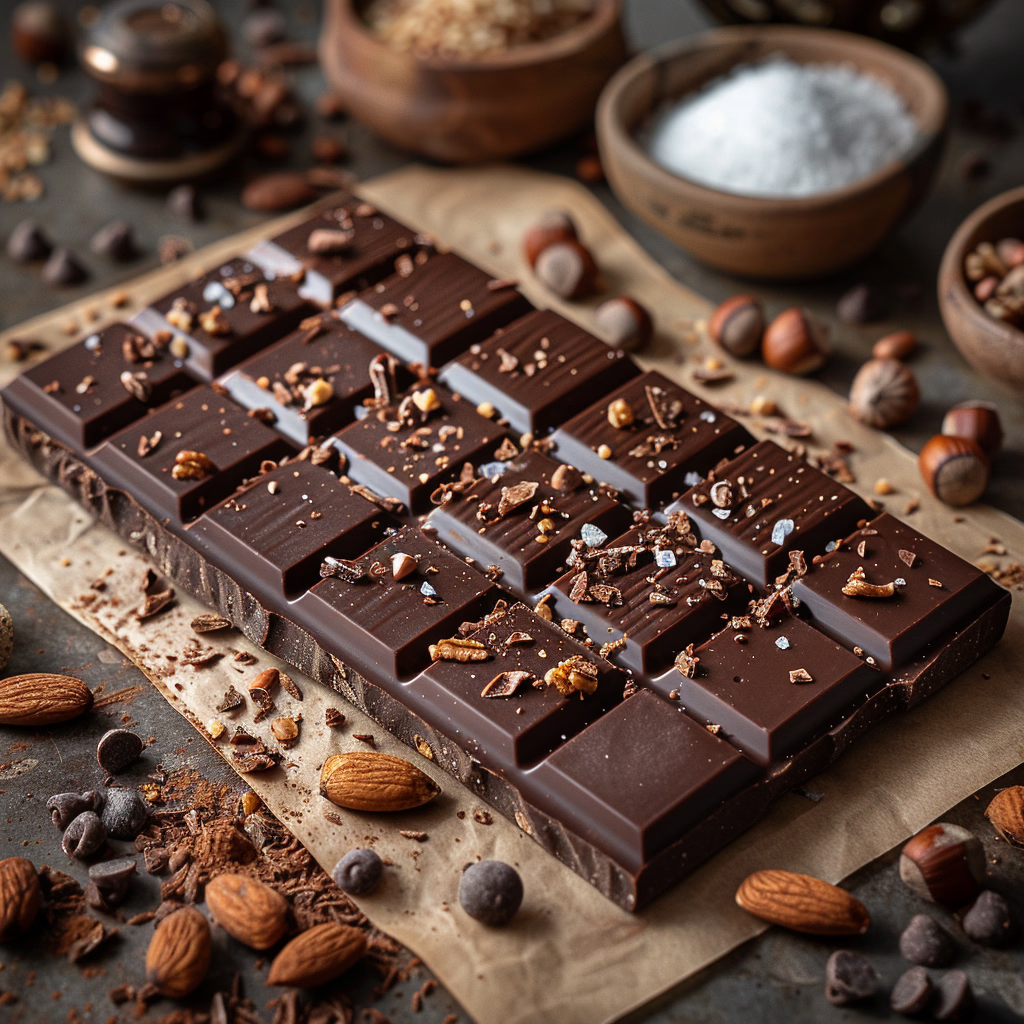Introduction
Have you ever wondered how to make chocolate from scratch? Crafting chocolate at home is a rewarding experience that combines creativity, patience, and a love for rich, indulgent flavors. From roasting cocoa beans to tempering and molding the final product, every step is a journey that transforms raw ingredients into a luxurious treat. In this guide, we’ll walk through every stage of the process, share tips for troubleshooting, and even explore some variations to suit your tastes. Let’s dive into the sweet art of chocolate making!
Part 1: Introduction to Chocolate Making
How Do You Make Chocolate from Scratch?
Making chocolate at home starts with understanding the core ingredients and processes that bring this confection to life. Unlike store-bought chocolate, homemade chocolate gives you full control over flavors, textures, and sweetness levels.
Understanding the Basics of Chocolate Production
Chocolate is derived from cocoa beans, the seeds of the cacao tree, which undergo fermentation, drying, and roasting before becoming the chocolate we know and love. The process requires patience, attention to detail, and a few specialized tools. But don’t worry—it’s as fun as it is rewarding!
The Journey from Cocoa Bean to Chocolate Bar
The transformation of cocoa beans into a chocolate bar involves several key steps. First, beans are roasted to develop their unique flavors. Then, the outer shell is removed, leaving behind cocoa nibs that are ground into a paste called chocolate liquor. This paste is refined and tempered to create the smooth, shiny chocolate we’re all familiar with.
Part 2: Sourcing and Preparing Ingredients
Selecting Quality Cocoa Beans
The foundation of exceptional chocolate lies in selecting high-quality cocoa beans. Opt for beans that are organically grown, ethically sourced, and fermented properly for a rich flavor profile. Look for a deep brown color and avoid beans with a musty or sour smell—signs of improper processing. You can purchase cocoa beans from specialty stores or online retailers, ensuring they meet your desired quality standards.
Additional Ingredients Needed for Homemade Chocolate
Besides cocoa beans, you’ll need a few essential ingredients:
- Cocoa butter: Extracted from cocoa beans, it adds smoothness and a creamy texture.
- Sugar: Choose cane sugar, coconut sugar, or your preferred sweetener for a personalized touch.
- Milk powder (optional): Adds a rich, milky flavor for milk chocolate.
- Flavorings: Vanilla beans, salt, or even a touch of cinnamon can elevate your chocolate.
You can experiment with inclusions like nuts, dried fruit, or spices to create custom chocolate bars.
Equipment Essentials for Chocolate Making
Homemade chocolate making requires the right tools to ensure precision and quality. Here’s what you’ll need:
- Roasting Pan: For evenly roasting the cocoa beans.
- Cracking and Winnowing Tools: To remove the outer shell from the beans.
- Grinder or Melanger: For grinding cocoa nibs into a fine paste.
- Thermometer: Crucial for tempering chocolate to the right temperature.
- Molds: Silicone molds make shaping and setting your chocolate easy.
Investing in quality equipment ensures a smoother process and better results. Many tools can be found online or at kitchen supply stores.
Part 3: The Chocolate Making Process
Roasting Cocoa Beans
Roasting is the first crucial step in chocolate making. It enhances the flavor of the cocoa beans by reducing their bitterness and developing their unique aroma. Preheat your oven to 250°F (120°C), spread the beans evenly on a baking sheet, and roast for 20–25 minutes. Be sure to stir the beans occasionally for even roasting. The key is to avoid over-roasting, which can cause the beans to taste burnt.
Roasted beans will crackle slightly, and their shells will become brittle, making them easier to remove. Allow the beans to cool completely before moving on to the next step.
Cracking and Winnowing the Beans
Once the beans are roasted and cooled, it’s time to separate the nibs from the shells.
- Cracking: Place the beans in a sturdy bag or use a cracking tool to break them into smaller pieces.
- Winnowing: Use a hairdryer or winnowing machine to blow away the lighter shells, leaving the cocoa nibs behind.
This process may require patience, but the result is a pile of clean cocoa nibs, ready for grinding.
Grinding and Refining Cocoa Nibs
Grinding the nibs transforms them into a paste known as chocolate liquor. For this step:
- Use a stone grinder or melanger to grind the nibs slowly.
- The friction generates heat, which melts the nibs into a thick, smooth paste.
- Gradually add cocoa butter and sugar for a balanced flavor.
Grinding should take several hours to achieve the right consistency. This stage is critical for creating silky, high-quality chocolate.
Conching: Developing Flavor and Texture
Conching is the process of aerating and mixing the chocolate liquor to refine its flavor and texture further. Using a melanger or conching machine:
- Continue grinding and mixing the chocolate for 12–48 hours.
- Add any flavorings, such as vanilla or salt, during this stage.
- Taste the chocolate periodically to adjust sweetness or flavor balance.
Conching helps remove undesirable acidity and ensures a smooth, melt-in-your-mouth texture.
Tempering Chocolate for a Perfect Finish
Tempering is what gives chocolate its glossy finish and snap. Follow these steps:
- Melt the chocolate to about 115°F (46°C).
- Cool it to 82°F (28°C) by stirring it on a cool surface.
- Reheat it slightly to 88–90°F (31–32°C).
Tempered chocolate is now ready to mold and set. This step is essential for achieving professional-quality results.
Molding and Setting Your Chocolate
Pour the tempered chocolate into molds of your choice. Tap the molds gently on the counter to remove air bubbles. Allow the chocolate to set at room temperature or in a cool, dry place. Avoid refrigeration, as it can cause the chocolate to bloom (develop a white coating).
Once hardened, remove the chocolate from the molds, and it’s ready to enjoy or share!
Part 3: The Chocolate Making Process
Roasting Cocoa Beans
Roasting is the first crucial step in chocolate making. It enhances the flavor of the cocoa beans by reducing their bitterness and developing their unique aroma. Preheat your oven to 250°F (120°C), spread the beans evenly on a baking sheet, and roast for 20–25 minutes. Be sure to stir the beans occasionally for even roasting. The key is to avoid over-roasting, which can cause the beans to taste burnt.
Roasted beans will crackle slightly, and their shells will become brittle, making them easier to remove. Allow the beans to cool completely before moving on to the next step.
Cracking and Winnowing the Beans
Once the beans are roasted and cooled, it’s time to separate the nibs from the shells.
- Cracking: Place the beans in a sturdy bag or use a cracking tool to break them into smaller pieces.
- Winnowing: Use a hairdryer or winnowing machine to blow away the lighter shells, leaving the cocoa nibs behind.
This process may require patience, but the result is a pile of clean cocoa nibs, ready for grinding.
Grinding and Refining Cocoa Nibs
Grinding the nibs transforms them into a paste known as chocolate liquor. For this step:
- Use a stone grinder or melanger to grind the nibs slowly.
- The friction generates heat, which melts the nibs into a thick, smooth paste.
- Gradually add cocoa butter and sugar for a balanced flavor.
Grinding should take several hours to achieve the right consistency. This stage is critical for creating silky, high-quality chocolate.
Conching: Developing Flavor and Texture
Conching is the process of aerating and mixing the chocolate liquor to refine its flavor and texture further. Using a melanger or conching machine:
- Continue grinding and mixing the chocolate for 12–48 hours.
- Add any flavorings, such as vanilla or salt, during this stage.
- Taste the chocolate periodically to adjust sweetness or flavor balance.
Conching helps remove undesirable acidity and ensures a smooth, melt-in-your-mouth texture.
Tempering Chocolate for a Perfect Finish
Tempering is what gives chocolate its glossy finish and snap. Follow these steps:
- Melt the chocolate to about 115°F (46°C).
- Cool it to 82°F (28°C) by stirring it on a cool surface.
- Reheat it slightly to 88–90°F (31–32°C).
Tempered chocolate is now ready to mold and set. This step is essential for achieving professional-quality results.
Molding and Setting Your Chocolate
Pour the tempered chocolate into molds of your choice. Tap the molds gently on the counter to remove air bubbles. Allow the chocolate to set at room temperature or in a cool, dry place. Avoid refrigeration, as it can cause the chocolate to bloom (develop a white coating).
Once hardened, remove the chocolate from the molds, and it’s ready to enjoy or share!

